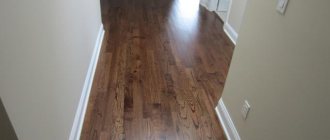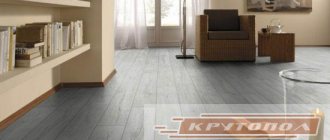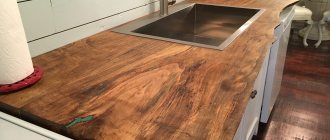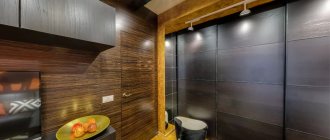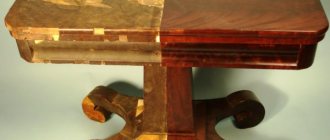Features of the material
Stain is produced in liquid form, more often it is a dark-colored composition that can give the wood a translucent tint. With its help you can radically change the appearance of furniture. The liquid penetrates deep into the wood, changing its color without disturbing the texture or pattern. Special varnishes are used in the restoration of all kinds of products, for bleaching and lightening.
The main feature of multifunctional compositions is the absence of a film after drying, revealing a natural pattern. The surface becomes contrasting and juicy. Staining is the most effective way to protect wood from rotting and deformation. When working, you can combine different shades of the mixture for all species - pine, oak, walnut, rosewood.
Types of stain
The main component of the stain can be oil, water or alcohol. A typical division allows us to distinguish several types of material, each of which interacts with wood differently. Some penetrate deeply into the wood, while other mixtures change the tone of only the top layer.
Water based
The largest group of impregnations. The mixture is available in ready-made form, which does not require additional preparation for application, or in powder form. The second option is preferable, since it becomes possible to independently adjust the shade. The color saturation will depend on the amount of bulk substance.
Water-based stain can be used indoors and outdoors. It has no unpleasant odor and is absolutely non-toxic. The composition has low consumption and is easy to apply. Among the disadvantages, poor water resistance can be noted. After application, wood fibers rise, which opens the way for moisture. The painted surface takes a long time to dry – 12-15 hours. Not recommended for use on resinous wood species.
Working with water stain is easy with your own hands. The technology consists of pre-wetting and sanding the parts. Sandpaper works well to remove raised hairs. Before use, filter the mixture and mix well. Moisture resistance can be increased by using a finishing varnish coating.
Oil based
Universal oil-based mixtures include special oil-soluble dyes. This stain dries quickly (2-4 hours), is easy to apply, lays flat on any surface without swelling the wood fibers. With this composition you can easily cover the wood evenly and without streaks.
In preparation for application, oil stain must be diluted with a solvent. In addition to decorative functions, the composition has excellent protective properties. The oil penetrates deeply into the top layer of wood, does not allow it to become damp under the influence of external factors, and maintains air exchange.
Drying oil mixtures can be applied with any tool and method, manually or with a spray gun. You can achieve different shades, even those not typical for the breed, by adding a dye of the desired color. In this way you can make white, green, red stain. It will retain the richness of the shade for a long time, since it does not fade in the sun and does not wear off.
Alcohol based
Mixtures based on denatured alcohol are produced in ready-made liquid form or as powders. The cost of such stain is significantly higher than other analogues. The question of why use an expensive composition finds an answer in the high quality and special characteristics of the varnish.
Colorants are instantly absorbed into the surface, reducing drying time to 15 minutes. The obvious advantage can also be seen as a disadvantage, since deep and rapid penetration when painting will create big problems when removing the top layer in the future. Among the disadvantages, one can also note the difficulty of application and the unpleasant pungent odor. You can avoid such consequences if you apply alcohol stain correctly:
- Distribute evenly over the surface;
- Work quickly, thinking through the painting sequence in advance;
- Use a spray bottle.
Acrylic stain
New acrylic-based mixtures do not have many of the disadvantages inherent in oil solutions. The main advantages are the creation of a beautiful surface, the possibility of tinting in any color, and imparting water-repellent properties. Acrylic stains are often used to decorate individual areas of wood. Due to their high wear resistance, they can be used for painting plank floors and parquet boards.
Acrylic-based solutions are safe for humans and animals during work and during the operation of treated items. Such stains do not emit toxic fumes, do not have an unpleasant odor, and fit perfectly on flat surfaces.
The only negative is the high cost. It is better not to use acrylic mixtures as a starting coating before applying varnishes and polyurethane mixtures. The solution is not absorbed into the wood and forms an additional protective layer on the surface.
Wax stain
Used for restoration of old wooden coverings. With the help of wax stain, color discrepancies are painted over, the design is complemented, and faded and darkened areas are hidden. The compositions have high moisture resistance and create a dense film on the surface. Stains are presented in a huge range of colors. A significant drawback is vulnerability to mechanical damage and the need for subsequent varnish coating.
The wax stain is applied using a piece of cloth or a tampon by gradually rubbing it in. The mixture has the consistency of soft wax and is available in small containers. Before use, the wax stain is heated, increasing its penetrating ability. The wood is painted along the grain in several layers until the desired shade is obtained.
When choosing wax compounds, it is necessary to take into account that they do not impregnate the wood, but only create a protective layer.
Stains with whitening effect
White color will make any interior elegant. These can be bleached floors, plain walls, ceilings, pieces of furniture. Achieving the required degree of whiteness of wooden objects is very simple. One of the available means is stain with a whitening effect.
Wood can be processed in several ways. The choice of method and additional materials will depend on the location of the wooden object. If the wood will be located indoors, you can use a product for bleaching that emphasizes the direction of the fibers and the natural shade. Often used for artificial aging in antique style. In this case, the wood pores must be deep and sharp. Gray oil, acrylic, and wax stains are used. The main task of stains for outdoor use is to protect wood from rotting and blueing.
Wood stain colors
There are a huge number of shades of wood stains on sale. It is best to select them after testing on a specific material, but this is not always possible. In such a situation, you need to look at the name of the tone, because the manufacturer is obliged to indicate the color according to the international classification. However, even identically named colors from different manufacturers can produce different effects. On new, untreated wood, stain looks different than on boards that have been in use for a long time.
The darkest stains are most often used - they are the ones that give the wood the most noble appearance. With them, even larch and maple will resemble an oak board. Colorless stains are also in demand, which retain their natural shade but still provide full protective properties.
The most popular stain colors are:
- pine - a light coating, almost no different from natural;
- oak – a very beautiful dark brown tone;
- bleached oak - an interesting color with full preservation of the structure of the tree;
- stained oak (gray stain) – matte finish with a grayish tint, which must be protected with varnish;
- ebony – gives the effect of artificial aging, a “living floor” with each knot highlighted;
- walnut - can be light, medium, dark, like the wood of the same name;
- mahogany is a noble shade, often applied to tables and chairs;
- mahogany - an elegant dark shade with a red tint;
- wenge is a dark chocolate color, spectacular, providing an “expensive” look to the wood;
- cherry is a popular tone, it can be dark or light, the latter is used as a protective coating, since it almost does not change the basic color of the wood;
- Rowan - a pale beige color that needs to be applied 2-3 times;
- ash – leaves the original appearance of the wood, emphasizing its structure, and when re-applied gives a pleasant pinkish tint;
- plum is an interesting dark pink tone.
Also popular stain colors are rosewood, alder, teak, marigold, olive and many others. Modern stains are able to give wood the most unusual shade, although bright colors are less in demand than natural ones. Of those that are in demand, the following types of stains should be indicated:
- black - provides a feeling of antiquity, also used for painting ship hulls;
- fern is a green stain, ideal for children's furniture;
- mocha – gives the color of freshly brewed coffee;
- Oregon – paints the wood a dark red shade, very rich and bright;
- lemon – a beautiful yellow shade, to enhance the tone, apply in 2 layers;
- hazelnut – looks like the shell of the corresponding nut.
The color intensity of the stain will directly depend on the type of wood it is applied to. It is much easier to darken the initially dark color of wood than to give a rich shade to light material.
White wood stain
White furniture always looks stylish and fresh. To lighten the surface, it is not necessary to use paint; it is enough to purchase a special whitening stain. It will make the product much lighter and emphasize its structure. At the same time, the product will protect the wood from adverse environmental conditions. If the item will be used outside buildings, it is better to choose stains with high water-repellent properties, for example, acrylic. For dry rooms, water-based stain is suitable.
White furniture or flooring painted with such means will visually expand the room. Wood treated with lightening agents can also be used on walls to achieve a distressed look, which is very popular in vintage styles.
Color variety
The most popular are natural shades of stains, which best harmonize with the wood. For furniture finishing, bog oak and walnut are often chosen. Wenge, mocha, and nutmeg will give wood a browner color. The burgundy palette includes mahogany, maple, and cherry.
You can achieve the desired shade by mixing several types of stains. It is important to maintain proportions and use mixtures from only one manufacturer. For larch and pine, both dark and light walnut options are suitable. This paint is classified according to the international standard. Each color has a name and its own code.
When choosing a mixture, a test coloring of the wood is carried out. The resulting shade will be influenced by the natural color and type of material. The quality and density of solutions is of great importance. Compositions with the same numbers from different manufacturers can produce shades of different saturation and depth.
General characteristics of ProArt stains:
- All ProArt stains are concentrates that can and should be diluted to the desired saturation. When using concentrates in their pure form, the result is a strong, extremely dark or saturated color from one coat of coating.
- Subject to storage rules, the shelf life of stains is unlimited.
- Before use, be sure to thoroughly mix the stain to achieve uniformity of the material.
- All stain colors of one base mix perfectly with each other to obtain the desired color and shade.
ArtBlank.
Rules and methods of application to the surface
There are several ways to apply stain to the surface. When choosing, it is necessary to take into account the type and type of wood, since the texture will appear differently on each one. The following staining methods are used:
- Using a spray gun. Suitable for alcohol and nitro stains used over large areas. Device settings affect color effects. Using spray guns is the best option for an even application.
- Pouring or dipping. Used when applying mixtures of low viscosity and quick-drying, for example, water-based stains. Positive aspects - material savings, high productivity. Due to the absence of the human factor, ideal tone repeatability is noted. In hard-to-reach places, the formation of unpainted areas is excluded.
- Tamponing, impregnation with rags. As a tool, you can use foam rubber or cotton materials that do not leave fibers behind. The thickened wax and acrylic mixture is used in small areas. It is carefully spread over the surface until the desired color is obtained.
- Painting with a brush. Devices with natural bristles are suitable for oil mixtures, and synthetic fibers are suitable for water ones. The brush should be strong and of medium hardness. If the surface is large, the device should also be massive and wide. It is better to start working from the top edge, moving down.
Master class on wood tinting
It is easy to do the tinting of any wood or part of furniture with your own hands at home. The procedure will enhance the texture, give a refined shade, mask defects, and, if necessary, radically change the appearance of the wood. First of all, you need to decide on the tone of the stain, choose an application technology and check the color on a piece of wood of the same species. The process of applying the mixture itself takes place in several stages:
- Surface preparation. The base is thoroughly sanded and cleaned. Then moisten it with water and remove the standing fibers using sandpaper.
- Applying the tinting mixture. Start painting after the wood has completely dried. Apply one layer of color and remove excess stain with a cloth.
- Drying. Each type of tinting composition has its own drying time. After a certain time, we check the consistency of the shade and, if necessary, apply a second layer.
- Varnishing. Applying a protective layer is necessary to give the surface greater strength.
Purpose of stains
The simplest definition of what a stain is is a composition for impregnating wood, as a result of which the latter can change its shade.
On a note! Wood stain is the modern name. Initially, such solutions were known as “ beans ” (German: Beize - dye). Also at one time the name “Cologne land” was widely used - since the first beys received it from humus, which was mined near the city of Cologne. The humus was soaked in water, and the wood treated with the resulting composition acquired a brown tint.
But to use stain correctly, you need to understand the mechanism of its action, because, for example, with ordinary paint, it is much easier to give a wooden surface the desired color. The point here is that painting is essentially the application of a colored film to the surface, behind which the structure of the wood is hidden. And tinting with stain is precisely the impregnation of at least the top layer of wood. At the same time, chemical reactions occur, as a result of which the tree changes its color, and what is most remarkable is that the structure of the wood not only remains visible, but also becomes more pronounced.
This feature of staining wood is widely used when it is necessary to “fake”, for example, a product made from alder - to “make” oak out of it. But in general terms, the main purpose of stain is simply changing the color tone of the wood. At the same time, the range of applications of modern stains is quite wide, since additional dye can be introduced into them.
Also, certain types of stains can provide additional protection for wood from the adverse effects of external factors. At the same time, various types of finishing coatings can be additionally used to improve the characteristics.
Table covered with stain and oil Source rest-vm.ru
What is wood stain used for, the most common options:
- Toning of wooden surfaces.
- During restoration in order to restore the original color.
- To imitate valuable wood species.
- As an antiseptic.
- To add texture to a natural pattern.
- To protect against adverse factors. Some types have water-repellent properties.
That's basically all why wood stain is needed.
Flow calculation
The main indicator that must be taken into account when calculating consumption is the degree of porosity of the base material. Any stain has excellent absorbency. On average, one liter of composition is required per 15 m2. It is also important to consider the intensity of the shade. Conifers have low absorbency, so they will need to be processed in several layers to achieve the desired pattern, which will at least double the consumption.
The amount of material used is affected by the shape of the surface to be painted, the presence of corner locks, and hard-to-reach places. On each container of the mixture, manufacturers indicate how much mixture must be used to obtain a certain pattern. The exception is oil compositions, the task of which is to saturate the wood until the pores are completely filled. In this case, the type of tree and its condition are taken into account.
To reduce stain consumption when painting coniferous wood, it is necessary to remove tree resin from the base in advance.
Exploitation
Before you paint wood with stain, you need to choose it. Let's start with this:
Stage No. 1: composition selection
Range of water-based solutions
All stains, depending on their composition, are divided into the following groups:
| Group name | pros | Minuses |
| Water |
|
|
| Alcohol |
|
|
| Nitro (solvent based) |
|
|
| Oily |
|
|
Oil stain for wood for interior use
Tip: When using toxic compounds indoors, be sure to wear a respirator. Otherwise, you may get seriously poisoned.
Photo of a respirator for working with toxic solutions
Separately, it is worth mentioning acrylic stains, which are also water-based, but at the same time have greater strength and do not raise the pile during application. But such a product costs much more.
Example of acrylic stain
Stage No. 2: choosing a color
Samples of shades of applied stains
The impregnation color is selected in accordance with a special international classification, an example of which is shown above in the figure.
But you should not rely on the conventional name alone for the following reasons:
- Differences in production technology. Each manufacturer has its own specifics for making stain, which also affects its tone. So, for example, “Larch” of “Tsaritsyn Paints” has a brownish-pink tint, and a similar class from “Novbytkhim” is distinguished by a delicate yellowish color.
- Structural features of the processed wood. More porous rocks will absorb the solution faster, and those with a pronounced texture will collect it in relief patterns, all of which will affect the final appearance of the coating.
Color differences according to wood structure
Advice: it is better to choose the required color using specially colored dies, which are provided in specialized stores as samples. This is the only way you will get the most complete idea of the final shade of the stain applied.
This is what the provided samples look like
Stage No. 3: choosing a tool
Staining with a brush
Depending on how long it takes for wood stain to dry, you should choose the tool that will be used to apply it:
| Name | Comments |
| Spray | It is noteworthy that the nozzle diameter should not exceed 1.5 mm. Allows you to perform processing quickly and evenly, which is simply irreplaceable when using quick-drying alcohol compounds and nitro stains. |
| Wide brush | For oil-based solutions on wood, it is recommended to choose a product with natural bristles, for water-based ones - with synthetic ones. Allows you to apply fewer layers than when using a spray gun. |
| Tampon | Also suitable for oil and water based formulations. In this case, more time is spent on work, but material consumption is more economical. |
Staining with a tampon
Stage No. 4: surface preparation
Also, even before painting wood with stain, it is necessary to prepare it in a certain way:
- We remove the old coating by sanding and scraping the wooden surface. This way we simultaneously level it for better processing.
Sanding a wooden surface with an electric sander
- We remove grease stains by wiping them with a rag soaked in white spirit.
- If the work is carried out with coniferous wood, then it will also be necessary to eliminate the natural oils in its structure, which otherwise will interfere with the penetration of the stain. The following solutions are suitable for this task:
- We heat one liter of water to 60 degrees Celsius, after which we add potassium carbonate in the amount of 50 g and soda ash - 60 g.
- We create a five percent soda solution by diluting 50 g of caustic soda in one liter of warm water.
- Combine 0.75 liters of distilled water with a quarter kilogram of acetone.
We apply any of the listed mixtures in several layers to the wood, and after thirty minutes we wipe it with a rag and rinse with warm water.
Stage No. 5: staining
Now let's directly look at how to apply stain to wood:
- We warm up the solution a little, which allows us to increase the intensity of its penetration into the wood surface.
- Moderately moisten the tool chosen for work in stain. Excessive moisture can cause streaks to form. If using a spray bottle, fill its tank.
- We process the wood along the grain with confident and continuous brush movements to avoid the appearance of stains.
Treating a wooden structure with stain is performed with confident movements.
- Remove any excess solution with a clean rag.
Removing excess stain
- Leave the surface until completely dry.
- Then apply another 2-3 layers in a similar way to create the desired shade saturation.
How to choose a stain
The choice of stain is influenced by the purpose of the item being processed and the method of its application. To tint furniture items, choose safe mixtures with a minimum amount of volatile compounds. Wax, oil, and water-based formulations are suitable.
To treat window frames and doors, it is better to select alcohol stains. The mixtures are easier to apply to smooth surfaces, which minimizes staining. You can restore old tables, chairs, cabinets with small blue stains using oil and wax compounds using any tool. When choosing a tonic, you should pay attention to the following characteristics:
- Drying speed. Alcohol compositions dry almost instantly; stains on water take 2-3 hours. Oil solutions will require at least 24 hours to dry completely;
- Toxicity. The safest stains are oil, water, and wax. Acrylic and alcohol mixtures are applied in protective clothing and a respirator;
- Resistance to fire and mechanical damage. Fire resistance depends on the thickness of the layer. Oil and wax stains have the lowest degree of protection against scratches;
- The degree of filling of wood pores. Oily compositions have the highest pore filling rate;
- No smell. Water-based and acrylic stains are completely odorless. Vapors from oil mixtures dissipate within a few days.
General provisions
Stain for exterior woodwork in a jar
The main feature of stain is that, unlike paints and varnishes, it does not create a film layer on the wooden surface, but penetrates deep into its fibers.
This allows us to highlight the inherent advantages of such a solution:
- Emphasizing and ennobling the natural wood pattern.
- Lack of sealing. Wood impregnated with the solution in question continues to “breathe.”
- Preservation of the texture of the wooden surface with all its roughness.
Tip: American physiotherapists recommend walking barefoot on a stained floor. In this case, massage provided to the remaining unevenness of the soles of the feet helps relieve the feeling of heaviness and fatigue.
It is useful to walk barefoot on a stained floor.
- Increased moisture resistance and resistance to mechanical damage. By filling wood pores, such compounds prevent further penetration of water through them and strengthen their structure.
- Frost resistance. The stain that has penetrated into the wood does not suffer in any way from exposure to low temperatures, unlike varnishes and paints for wooden surfaces, the layers of which have a limited number of freezing and thawing cycles.
Wood stain for outdoor use withstands winters without consequences
- Durability. Does not need restoration for many years.
Dealing with defects - what to do if the stain is applied incorrectly
Quite often, after applying stain, various defects form on the surface. They may not appear immediately, but only after drying. The sooner measures are taken to eliminate them, the greater the chance of complete restoration of the applied layer. Most often you have to work with the following defects:
- Streaks. If the resulting drip is noticed at the time of applying the stain, it must be impregnated with varnish, which will dissolve the bottom layer. Then the area should be wiped with a clean rag and treated with the mixture again. The already dried streak is first softened with a solvent, then removed with a knife, plane, or sandpaper.
- Stains. First of all, it is necessary to determine the cause of their occurrence. The problem may be poor quality wood that has black areas that unevenly absorb the stain. In the case of external solid wood, a plane will help; all the veneer will need to be removed from the plywood. It is better to re-coat the area with a thick wax mixture.
In what cases is it necessary to coat wood with stain?
Stain and protective compounds (impregnation) for wood are applied in the same way as if you just wanted to paint it. You should apply the coating to the prepared wood quickly, but in order to get an even coat on smooth wood, you will need to do it very carefully. You must cover each surface continuously, otherwise, if the stain or impregnation on this area dries earlier than on the adjacent one, you will get a noticeable seam in this place.
Apply stain in the direction of the wood grain. Try not to put too much product on the brush and spread out any stray drips before they dry.
Be sure to finish one section before starting the next. At the junctions of two sections, make sure that the applied layers do not overlap. Coating wood with stain is a rather complex technological process. Practice first on an inconspicuous area of wood.
